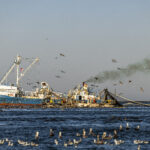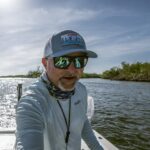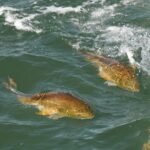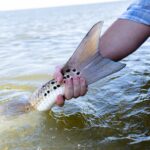
Gulf Menhaden Reduction Fishery: Bycatch Research & Useless Buffer Zones
Do you remember your driver’s test? How nervous were you when the instructor pulled out
Part 1: What went wrong and how we ended up here
From New England down to the mid-Atlantic, if you fish at all in the salt, you are likely well-aware of the downward trend in striper numbers.
To some, particularly those fishing eels down deep, trolling mojos, wire etc., in those few striper-central hold-outs (i.e. Montauk, Cape Cod etc.), the decline is less pronounced, allowing for a selfish minority to scream that everything is fine, as the rest of the angling community suffers a dearth of fish.
And then there are those with their “beer-reviewed science” who claim that Super Storm Sandy changed the paradigm. They know for certain that all the fish are simply “offshore” now, because a friend of a friend has a friend who’s a commercial fisherman who saw them so thick out there, you could walk on them. Of course, there is no science behind any such contention. In fact, the Northeast Fisheries Science Center no longer includes data from their offshore trawl surveys, because they were encountering so few striped bass.
To the rest of the community, at least the ones who choose not to wear blinders, the decline is pretty clear, and it has been, for many years. And, while there’s been plenty written about it, a 2019 benchmark stock assessment shows this in no uncertain terms. Such assessment is clear that striped bass are “overfished” (below a level biologists determine to be a healthy stock) and “overfishing” (taking fish out at a level that contributes to the decline) is occurring. Two things that have seemed quite obvious to a lot of us for years.
At the February Atlantic States Marine Fisheries Commission (ASMFC) meeting Commissioners were presented with a summary of such findings, although it was not yet official as the Government shutdown had delayed the final report. Instead of taking action then and there (i.e. emergency action, or simply initiating an addendum to correct the situation) the Board tasked the technical committee (ASMFC staff biologists) to come up with possible regulations that would get overfishing under control, which is the likely first step in the initiation of addendum anyway.
The Striped Bass Board will likely act on that memo at their April 30th meeting.
If we are to successfully advocate for strong corrective action, an avoidance of further half-measures and/or other short-sighted decisions, and a repeat of past mistakes, it’s important to understand the background and management history that led up to where we are now. In other words, how we got here, more specifically why we got here, and how to avoid more mistakes moving forward.
STRIPED BASS BIOLOGY
Stripers are anadromous, meaning that while they spend most of their lives along the coast and its estuaries, each spring, adults travel up natal freshwater rivers to spawn.
The great majority of the migratory coastal stock comes from the Chesapeake Bay, which produces about 80 percent of those fish, although the Hudson River and Delaware Bay also make significant contributions to the coastal population. Beside the big three, there are dozens of rivers reaching as far north as Maine that have minuscule spawning populations. In total, however, spawning from those rivers contributes less than 1 percent of the fish to the coastal population.
Female striped bass reach sexual maturity at around age six (26 to 27 inches) while males mature at around age two (17 to 18 inches). Fecundity of female striped bass is directly related to the fish’s size. A 30-inch fish may produce a million eggs, while a 50-inch fish can put out over four-million.
Each spring as the water warms, spawning-age stripers begin migrating up freshwater rivers. On the spawning grounds, males fertilize eggs before such eggs drift downstream and eventually hatch into larvae, where they immediately begin feeding on zooplankton. Soon, if they can manage to avoid getting eaten by something, they develop into two to four-inch little stripers, what biologists and fishery managers call “young of the year”.
Seine surveys of such young-of-the-year striped bass have been conducted by the Maryland DNR at very specific locations in the Chesapeake Bay since 1954. Such “Juvenile Abundance Indices” (JAI) are generally pretty accurate in determining future coastal abundance. In part, striped bass are managed with such indices and future projections in mind.
MANAGEMENT AUTHORITY
Atlantic striped bass are managed by the Striped Bass Management Board of the Atlantic States Marine Fisheries Commission (ASMFC).
ASMFC describes itself as “An Interstate Compact, ratified by the states and approved by the U.S. Congress in 1942, acknowledged the necessity of the states joining forces to manage their shared migratory fishery resources and affirmed the states’ commitment to cooperative stewardship in promoting and protecting Atlantic coastal fishery resources.”
We should be clear here that while ASMFC indeed has an Interstate Fisheries Management Program Charter, which would seem to compel the Commission to prevent overfishing, rebuild overfished stocks and base its management measures on the best available science, unlike federally managed fisheries, it is under no legal obligation to so. We plan to cover this in more depth in part three of this series.
MANAGEMENT HISTORY
Most readers are aware of the prior striped bass stock collapse. In the early 1970s, the population began a long and precipitous decline. Declining water quality and what had become rampant pollution in the Chesapeake Bay likely contributed, but in the end, “recruitment overfishing” was determined to be the major contributor to the decline. In other words, too many fish were being killed before they could spawn and replace themselves.
Despite what was at times overwhelming political pushback from fishermen and politicians, ASMFC adopted an Interstate Fishery Management Plan in 1981. Although the report spanned more than 300 pages, the plan ultimately did nothing to rebuild the striped bass stock.
Rebuilding didn’t begin until ASMFC adopted Amendment 3 to such management plan in 1985. Amendment 3 was a simple, 3-page document intended to protect what was a relatively strong 1982 year class, and all those spawned in subsequent years, by imposing a steadily increasing size limit that would ensure that 95 percent of all females from such year classes would survive long enough to spawn at least once.
Amendment 3 was given teeth by the 1984 Striped Bass Conservation Act, which required the states to comply with the plan or face a federally-imposed moratorium on striped bass fishing. During the mid-1980s, many states voluntarily imposed moratoria of various lengths, while the rest changed their regulations to comply with Amendment 3, by imposing constantly-increasing minimum size limits, that were expected to reach 38 inches in 1990. As a result, the abundance of females on spawning grounds in Maryland doubled between 1985 and 1988, and Maryland young-of-the year indices had begun to improve dramatically by the 90s.
In late 1989, ASMFC adopted Amendment 4 to the management plan after the three-year average of the Maryland’s juvenile abundance index rose above 8, the threshold used to define a “recovering” stock. Under Amendment 4, the states began to ease regulations in response to growing abundance. The commercial fishery remained greatly reduced compared to historical levels. Recreational bag limits of one fish were the rule in all states.
Improvement in the spawning stock and successive high young-of-the-year indices prompted managers to declare striped bass had fully recovered in 1995, 10 years after stringent, yet politically unpopular management measures were implemented.
Amendment 5 was then adopted to address management of recovered stocks. The amendment allowed all coastal states to adopt a two-fish bag limit and 28-inch minimum size, and substantially liberalized the commercial fishery. Through “conservation equivalency,” it also allowed the states to develop their own regulations as long as they achieved the same conservation goals as the new amendment.
Amendment 6 was passed in 2003 with the intent to maximize the overall benefits of the fishery. The goal was to manage fisheries in a manner consistent with maintaining a self-sustaining spawning stock and a broad age structure (i.e more larger fish in the stock). It did this through a new set of reference points and management triggers, which are very important in the context of how we got to where we are now.
REFERENCE POINTS
Amendment 6 employs “empirical reference points” and associated “triggers” that were intended to compel managers to react should such triggers be, well, triggered.
There is a female spawning stock biomass (SSB) “target” reference point (the number of spawning fish managers strive to keep fish in the water), and a “threshold” reference point for management action. The goal is to manage the striped bass population so that it remains near the SSB target; if the SSB falls below the threshold, the stock is deemed to be “overfished” and managers are compelled to build it back to SSB target.
Managers also have a fishing mortality (F) “target” reference point, intended to maintain the SSB at or near its target, and a higher threshold reference point that triggers management action.. If estimated fishing mortality exceeds the threshold, then we are “overfishing” the striped bass stock.
MANAGEMENT TRIGGERS
Amendment 6 also includes five “management triggers” that theoretically compel the Management Board to take corrective action should certain events occur.
1) If fishing mortality threshold is exceeded in any year, the Board must reduce the fishing mortality rate to a level that is at or below the target within one year.
2) If the female spawning stock biomass falls below the threshold in any given year, the Board must rebuild the biomass to the target level within no more than ten years.
3) if the fishing mortality target is exceeded in two consecutive years and the female spawning stock biomass falls below the target within either of those years, the board must reduce the fishing mortality rate to a level that is at or below the target within one year.
4) If female spawning stock biomass falls below the target for two consecutive years and the fishing mortality rate exceeds the target in either of those years, the board must rebuild the biomass to the target level within no more than 10 years.
5) If any juvenile abundance index (young of the year survey) shows recruitment failure (i.e., JAI is lower than 75% of all other values in the dataset) for three consecutive years, then the Management Board will review the cause of the recruitment failure (e.g. fishing mortality, environmental conditions, disease etc.) and determine the appropriate management action.
THE DECLINE
Chesapeake Bay young-of-the-year production has been comparatively good for the better part the last three decades. However, from 2006 to 2010 there were below average juvenile abundance indices in the Chesapeake Bay, presumably due to environmental conditions. We had one very good year class in 2011, then a very poor year class in 2012, and another pretty good one in 2015. Everything in between seemed to be about average. What we did not have was the abundance of good year classes we had in the years between 1993 and 2003. So it would have made sense that managers would promptly reduce fishing mortality on a stock that, for one reason or another, wasn’t as productive as it had been. But that wasn’t what happened.
2004 seems to have been the turning point for striped bass. In retrospect, it was the first year of a long decline that has not yet abated. A benchmark stock assessment released in 2008 indicated that biomass was decreasing but didn’t generate any concern among the Board as biomass remained above target and fishing mortality was at the target level.
However, by the Management Board’s October 2008 meeting, representatives from northern New England, particularly Maine, were beginning to express concerns over the apparent decline and loss of access to striped bass in their states’ waters.
Such concerns were ultimately justified by a stock assessment update released in 2011 which warned that “Female [spawning stock biomass] will fall slightly below the threshold by 2017 under both [the low and the average] recruitment scenarios,” at which point the stock would become overfished.
Despite such warning, the Management Board decided not to move forward with an addendum to Amendment 6 which, if approved, could have required landings to be reduced by as much as 40 percent.
Instead of releasing such addendum for public comment, the Management Board opted to postpone action indefinitely, with Commissioners justifying such action by noting that none of Addendum 6’s management triggers had yet been tripped, and that the strong 2011 Chesapeake Bay year class could correct the situation.
Addendum IV
Another benchmark striped bass stock assessment was completed in 2013. It demonstrated that, as of the end of 2012, fishing mortality had exceeded the target level for at least two consecutive years, and that female spawning stock biomass had fallen below its target in those years a well. Thus two of Amendment 6’s management triggers – trigger 3 (fishing mortality above target) and trigger 4 (female spawning stock biomass below target) had been tripped.
The Management Board acted in accordance with trigger 3, reducing fishing mortality to or below target, by adopting Addendum IV in 2014. Addendum IV sought to reduce fishing mortality to the target level and protect the large 2011 year class, by reducing fishing mortality by 25% on the coast and 20.5% in Chesapeake Bay.
While the addendum did succeed in constraining fishing mortality, it did not succeed in protecting the 2011 year class. Both the coastal and Chesapeake commercial fisheries, as well as the coastal recreational fishery, met or exceeded their expected reductions.
The recreational fishery in Chesapeake Bay failed to reduce its landings at all, and actually substantially increased its harvest. Much of the increased fishing mortality presumably came from the 2011 year-class Addendum IV sought to protect.
Unfortunately, Addendum IV contained no compliance provision which would have required recreational fishermen in Chesapeake Bay to achieve their assigned harvest reduction, and also contained no provision to hold them accountable should an overage occur. So long as overall fishing mortality was reduced to the target level, Addendum IV would be deemed successful. Thus, no additional management measures were adopted to constrain recreational landings in Chesapeake Bay.
2019: AN OVERFISHED STOCK, SUBJECT TO OVERFISHING
The 2018 Assessment was completed in late November of last year. Like most benchmark assessments, it incorporated new data, in this case including substantially revised recreational catch and effort estimates.
It made clear that the spawning stock biomass in 2017 was considerably less than the spawning stock biomass threshold, indicating the stock is overfished. And that fishing mortality was greater than the associated fishing mortality threshold, indicating the stock is experiencing overfishing.
So, two of Amendment 6’s management triggers, trigger 1 (overfishing) and trigger 2 (overfished stock) have been tripped and, according to the explicit language of Amendment 6, the Management Board must take action.
What action the Board ultimately takes is “to be determined” and will likely be decided at the Board’s scheduled April 30th meeting.
We should be very clear here that there is no guarantee that the Board will take significant and/or timely action. Because, well, they don’t have to. And I expect there will be considerable pressure on them, particularly from Maryland, to delay and ultimately avoid any real conservation measures that would not only fix the overfishing problem but rebuild the fishery.
The Management Board has even discussed drafting a new amendment that might push any new management measures out two to three years, and maybe even change the goals and objectives of the management plan, with a focus on adopting new reference points that would likely lower the standards for what a healthy striped bass stock looks like.
We will discuss this in further detail in part two of this series.
MISSED OPPORTUNITIES
The board could have, and arguably should have taken a different path after the 2011 Stock Assessment Update warned that the stock would become overfished in 2017. It could have taken management action then that would have substantially reduced fishing mortality, in order to prevent a further decline in spawning stock biomass and gradually rebuild it to the target level.
If such a management action been successful, the adoption of Addendum IV, and the continuing decline of the stock, might have been avoided. At worst, even if such effort had not have been completely successful, it would probably have slowed the rate of stock decline prior to the 2013 Assessment.
Instead, the board decided it was better to allow catch limits to remain constant until the stock became overfished or otherwise tripped one of Amendment 6’s management triggers.
Although the 2013 Assessment was slightly more optimistic than the 2011 Update, it still predicted that if fishing mortality remained unchanged, there was a substantial chance that the stock would become overfished prior to 2016, and that such risk would increase if no action was taken to reduce fishing mortality prior to 2014 or (as was ultimately the case) 2015.
Even if that did not occur, the 2013 Assessment still tripped management triggers 3 and 4, which addressed both fishing mortality that exceeded target levels and a female spawning stock biomass that also fell below target. But, the Management Board ignored management trigger 4, and its requirement to initiate a rebuilding plan, when it adopted Addendum IV.
Furthermore, the Chesapeake Bay recreational sector’s continuing failure to achieve the fishing mortality reduction, as required by Addendum IV, probably shouldn’t have been tolerated. The Management Board probably should have held Maryland accountable for its overages, which likely diminished the 2011 year class, and almost certainly contributed to where we are now.
Such accountability could have ranged from merely imposing more restrictive regulations in the following season, in an effort to end the overfishing, to the same sort of pound-for-pound paybacks that are currently used to govern the commercial fishery. Whatever their form, some accountability would have offered better protection for the 2011 (and perhaps 2015) year class, while reducing overall fishing mortality, and in the end, more fish would have been able to contribute the spawning stock biomass.
All this said, there is no guarantee that the stock would not still have become overfished by 2017, as the 2018 Assessment relied on data not available in previous assessments, and such data may still have led to a conclusion that the female spawning stock biomass had dipped below the biomass threshold.
However, it is very likely that, had a more risk adverse approach been taken, the spawning stock biomass would have been larger than it is today, that the fishing mortality rate would have been lower, and that the stock would have been in better condition than it is now.
NEXT WEEK
Stay tuned for part 2, and our recommendations on the direction the Board should go, and specific management actions the Board should take.

Do you remember your driver’s test? How nervous were you when the instructor pulled out

If you’ve spent any time on the water in South Florida, chances are you’ve heard

Photo Credit: Graham Tayloe Big Win for Redfish in Alabama Huge news from the Marine

Feature Photo: Carter Abramson | Simms Fishing at the Fisheries Science Symposium We have more
We rely on our members and donations to keep fighting for a sustainable tomorrow in marine conservation.
GIVE THE GIFT OF FISHERIES CONSERVATION THIS HOLIDAY SEASON. SHOP ASGA GOODS THAT FUND FISHERIES RESEARCH & ADVOCACY CAMPAIGNS
JOIN ASGA IN CALLING FOR CRITICAL MANAGEMENT ACTION AFTER YEARS OF SPAWN FAILURES & POOR MANAGEMENT.
By using this website, you agree to our use of cookies. We use cookies to provide you with a great experience and to help our website run effectively. To learn more, please review our privacy policy.